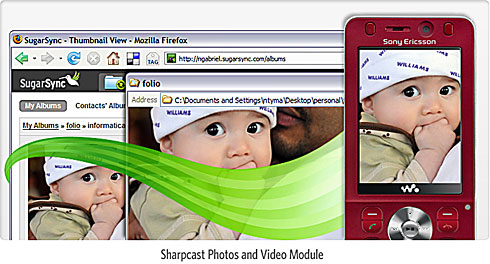Edward C. Baig
USA Today

With SugarSync Mobile, photos you take with your phone are automatically synced to your PC.
You use a computer at work, one at home and a third when you travel. You carry an Internet-capable smartphone, too. If only your documents, photos and other files could be synchronized across all of them (and the Web) so that when you alter a file on one, changes are reflected on the others.
That’s the promise behind a consumer-oriented “push synchronization” service called SugarSync. It launches Thursday from Silicon Valley start-up Sharpcast, whose photo-only sync service has been commercially available for a year.
SugarSync extends syncing to documents and other digital media files. It doesn’t matter if stuff resides on a Windows PC or Mac. I’ve been testing it on two Windows desktops (one running XP Pro, the other Vista Ultimate) and an iMac (OS X Leopard).
The service was buggy in my tests, and there’s room to add and improve some features. But I’m hooked on the concept.
SugarSync goes well beyond regular online backup services. You have remote access to your files, even from some mobile phones — no need to e-mail files to yourself or carry portable USB drives.
And there’s the syncing itself. SugarSync lets you work as always. You might create or change a document in Microsoft Word. SugarSync transparently handles the heavy lifting so that it is replicated on other machines, usually quite fast. Or rotate a photo in Google’s Picasa and have it refreshed elsewhere. Files reside in the same directories they always have.
PCs you are syncing need not be online (or even turned on) at the same time. If your work computer is off when you a tweak a file at home, the edits will sync automatically when the work machine reconnects online.
You can browse and send files on your computers from Web-capable phones. The mobile version of SugarSync is optimized to run on BlackBerry and Windows Mobile devices. You can take a picture from one of these smartphones and have images turn up on synced computers. You can’t yet sync documents.
I tested SugarSync from a Windows Mobile-powered Palm Treo and an iPhone. I could view pictures and documents on the Treo but only photos on the iPhone. Sharpcast is licensing its sync technology to wireless carriers, broadband operators and manufacturers.
The Mac version is glitchy. At times, changes I made to Word documents on the iMac were not immediately reflected on my PCs. Instead, I saw a “Pending Upload” message. Sharpcast says the Mac software was in its early “alpha” testing stage and only Thursday graduates to a more advanced “beta” stage. The company is shooting for a full 1.0 release later in the spring.
Here’s more on SugarSync:
•Pricing. Subscriptions are tied to the amount of online storage you have, rather than the number of machines you sync. You can sync as many machines as you want, but the service isn’t cheap. A basic subscription gives you 10 gigabytes of online storage for $5 a month or $50 a year. A 30-GB plan costs $10 a month or $100 a year. The top-tier 250-GB plan costs $50 a month and $500 a year. SugarSync includes a 45-day free trial. First year prices are half off for Sharpcast Photos subscribers and SugarSync beta testers.
•The kitchen sync. Upon signing up, you’ll be issued a secure personal website — username.sugarsync.com — so you can remotely view your stuff from any computer connected online.
You’ll have to download SugarSync Manager software onto each computer you actually want to sync. The software displays the folders and files you are syncing and backing up across all your machines. The initial upload can take days or even weeks.
There are a couple of ways to sync. A “full sync” ensures that changes to files and folders are replicated on all computers. While you can do a “full sync” from any folder, SugarSync includes a folder called Magic Briefcase that makes it convenient to drag in files you want to keep close tabs on.
Fully synced folders and files take up space on all the computers you are syncing. If space is cramped, you can do a “lite” sync to remotely fetch files on demand. Only when you save files will changes appear elsewhere.
SugarSync also gives you access to a Web archive to permanently store versions of files that are later deleted or modified.
•Contacts. You can import contacts from Gmail, Yahoo, Hotmail and AOL into a SugarSync address book (for e-mailing photos and files to pals). It’s an address book without spice. There are no fields for phone numbers, snail-mail addresses or other data.
Sharpcast plans to add all that later in the spring when you’ll also be able to import contacts from Microsoft Outlook. Also coming: the ability to remotely stream full playlists and albums that originate on another computer from a Web browser or mobile phone.
Once such new features arrive and bugs are addressed, this imperfect but worthwhile service promises to only get sweeter.

